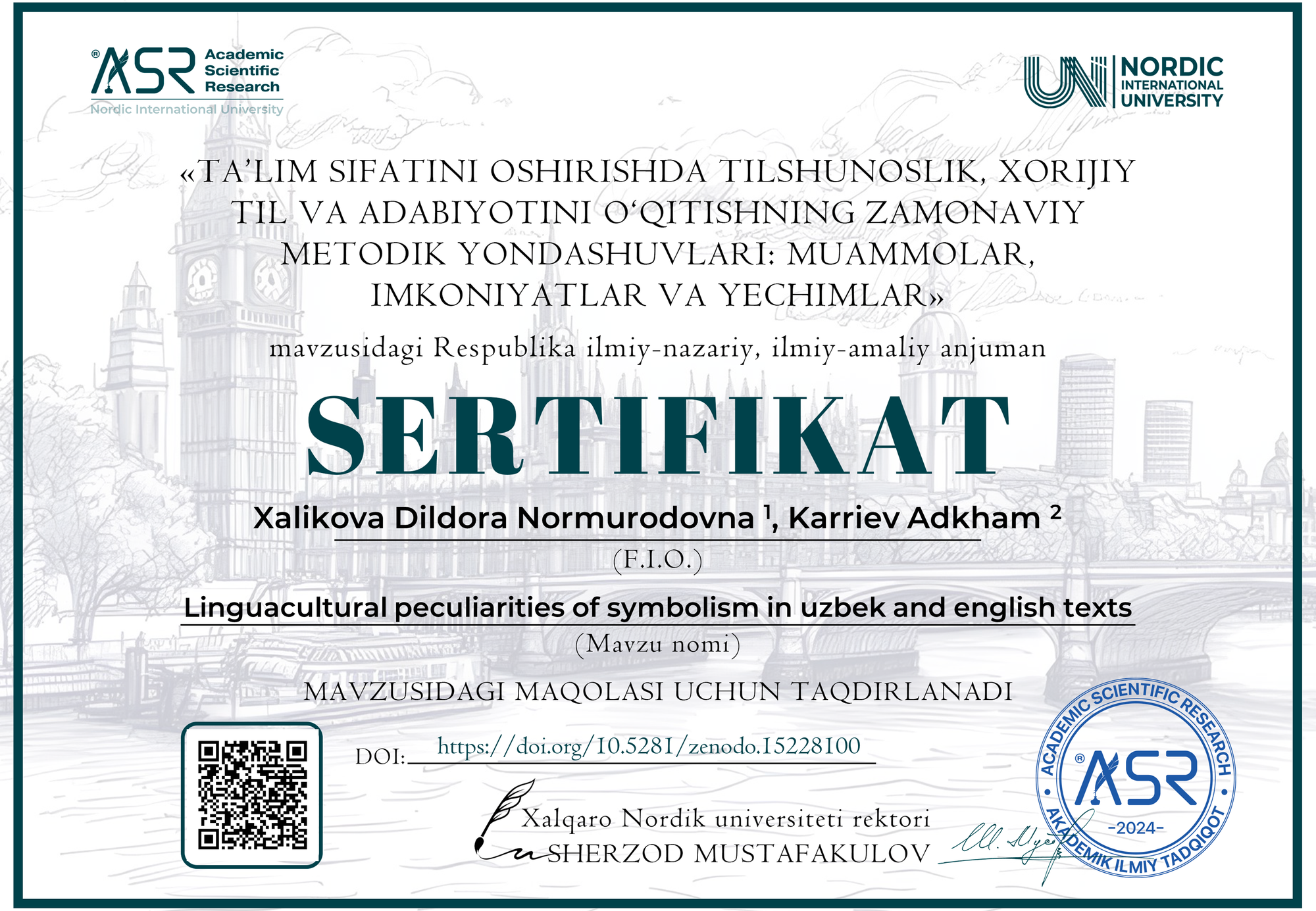Xalikova Dildora Normurodovna 1, Karriev Adkham 2

DOI: https://doi.org/10.5281/zenodo.15228100
Google scholar:
Zenodo community: https://zenodo.org/records/15228100
Nordic_press journal: https://research.nordicuniversity.org/index.php/nordic/article/view/2370
MAQOLANI YUKLAB OLISH
SERTIFIKATNI YUKLAB OLISH
REVIEW:
This article offers a thoughtful and well-researched comparative analysis of symbolism in Uzbek and English, effectively bridging linguistic theory and cultural studies. It stands out for its clear structure, rich citation of academic sources, and deep cultural insights. Below is a detailed evaluation of its strengths and areas for improvement.
Strengths
Topical Relevance and Originality
The study explores an under-researched area: comparative linguacultural symbolism between Uzbek and English. This comparative approach is both timely and necessary, especially for enhancing cross-cultural understanding in globalized educational and literary contexts.Strong Theoretical Framework
The article is grounded in classic and modern semiotic and cultural theories (Saussure, Peirce, Hofstede, Wierzbicka, etc.), providing a solid foundation for the analysis. References to both Western and Central Asian scholarship strengthen its academic credibility.Rich Cultural Contextualization
The authors successfully integrate concrete cultural symbols (e.g., the pomegranate, crescent moon, cross) and show how these symbols function within their respective societies. The section on the pomegranate is particularly well-developed and insightful.Comparative Analysis
The comparative structure throughout the paper is effective. It not only describes but interprets the socio-cultural implications of symbols, linking them with language families, religious influences, and worldview differences.Language and Clarity
The paper is written in academic English with generally clear expression and appropriate terminology. The use of subheadings enhances readability and logical flow.Areas for Improvement
Minor Language and Grammatical Edits
There are occasional grammatical and stylistic errors (e.g., "the both the 'star' and the 'crescent moon'" or "known as a or" – likely a typo). A thorough proofreading would help to polish the article.Depth of Discussion in Certain Sections
While the pomegranate is discussed in detail, other symbols such as the cross, lamb, or crescent moon are not as thoroughly analyzed in the same comparative depth. Including a few more detailed symbol comparisons would enrich the findings.Visual Aids or Tables
A comparative table summarizing symbolic meanings in both cultures (religious, historical, lexical, etc.) could greatly enhance the reader’s understanding and provide a quick reference.Methodological Clarification
Although the method section outlines the general approach, it could benefit from more specifics—e.g., how many sources were analyzed, what selection criteria were used, and whether any linguistic corpus or field data was employed.Conclusion Enhancement
The conclusion would be stronger if it briefly touched on the potential applications of this research—e.g., in translation studies, intercultural education, or linguacultural curriculum development.Recommendation
✅ Recommended with Minor Revisions
This paper makes a valuable contribution to the field of linguacultural studies and comparative symbolism. With minor revisions—mainly editorial and structural—it is suitable for publication in a peer-reviewed journal or presentation at an academic conference.



